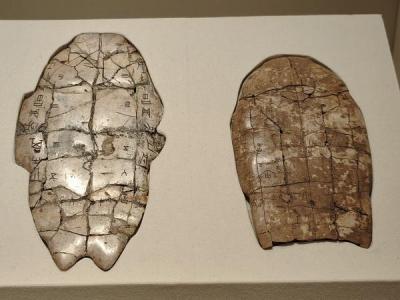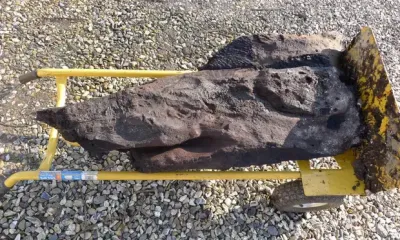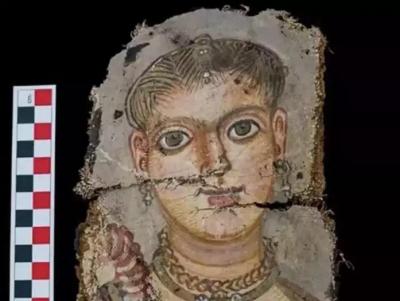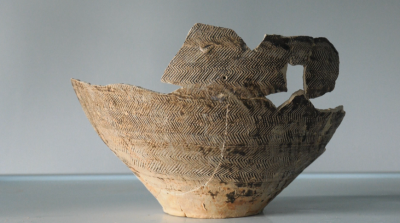INSTITUT SUPERIEUR D'ANTHROPOLOGIE
INSTITUTE OF ANTHROPOLOGY
ONLINE COURSES / COURS A DISTANCE
DEBUT COURS : JUIN 2023
REGISTER NOW
CHINE –  Yin - First discovered in 1899 at the Yin Ruins in Anyang, central China's Henan, "Jiaguwen," or the oracle bone inscriptions named for their mysterious "scratches" on bits of animal bones and on tortoise shells, are considered the oldest fully-developed characters as well as the origin of the Chinese characters people use today. Dating back to China's Shang Dynasty (1600-1046 B.C.), this ancient Chinese language was included in the UNESCO Memory of the World Register in 2017 and has long captured the heart of veteran Chinese archaeologist Liu Yiman. Having taken part in two of China's three major archaeological discoveries related to the oracle bone inscriptions over the past decades, Liu, a now-retired archaeologist from the Chinese Academy of Social Sciences, had her first encounter with these scripts in 1973, kindling around half-century long passion for her beloved inscriptions from some 3,000 years ago. Liu said the discovery of "Jiaguwen" marked a curtain-raiser for China to have its academic institutions conduct archaeological excavations, thus setting the country's archaeological excavations on a scientific track. For her, the interpretations of these oracle bone characters not only offer clues for the absolute dating – a technique used to calculate the exact age of a specimen – of the Yin Ruins, but also provide evidence to better determine and ascertain the ages of relics from later periods.When asked how many oracle bones had been identified so far, Liu Yiman, citing a book published in 2012, replied that in more than 120 years since the first discovery of "Jiaguwen," researchers have found around 4,400 characters on oracle bones and identified about one-third of them, with two-thirds still to be solved.
Yin - First discovered in 1899 at the Yin Ruins in Anyang, central China's Henan, "Jiaguwen," or the oracle bone inscriptions named for their mysterious "scratches" on bits of animal bones and on tortoise shells, are considered the oldest fully-developed characters as well as the origin of the Chinese characters people use today. Dating back to China's Shang Dynasty (1600-1046 B.C.), this ancient Chinese language was included in the UNESCO Memory of the World Register in 2017 and has long captured the heart of veteran Chinese archaeologist Liu Yiman. Having taken part in two of China's three major archaeological discoveries related to the oracle bone inscriptions over the past decades, Liu, a now-retired archaeologist from the Chinese Academy of Social Sciences, had her first encounter with these scripts in 1973, kindling around half-century long passion for her beloved inscriptions from some 3,000 years ago. Liu said the discovery of "Jiaguwen" marked a curtain-raiser for China to have its academic institutions conduct archaeological excavations, thus setting the country's archaeological excavations on a scientific track. For her, the interpretations of these oracle bone characters not only offer clues for the absolute dating – a technique used to calculate the exact age of a specimen – of the Yin Ruins, but also provide evidence to better determine and ascertain the ages of relics from later periods.When asked how many oracle bones had been identified so far, Liu Yiman, citing a book published in 2012, replied that in more than 120 years since the first discovery of "Jiaguwen," researchers have found around 4,400 characters on oracle bones and identified about one-third of them, with two-thirds still to be solved.
https://www.chinadaily.com.cn/a/202306/05/WS647d396fa31033ad3f7ba699.html
JAPON – Yoshinogari - The Saga prefectural government opened a sarcophagus on Monday that was unearthed at the Yoshinogari archaeological site in southwestern Japan and is preparing to study its contents. Excavated from the enormous ruins of a moat-enclosed settlement in Saga Prefecture, the stone coffin is believed to have been built around the second to third centuries in the late Yayoi period during the time of the ancient country of Yamatai. The coffin is around 2.3 meters long — bigger than other graves found at the site. On Monday, the Saga government opened the coffin, which has four stone lids. The prefectural government believes that an individual in power was laid to rest there, as the coffin was excavated from the top of a hill and the coffin lids were found with “x” marks etched on the surface. Experts say that such markings were believed to have been made to pray for the souls of the dead and prevent the dead from coming back to life again. The area where the stone coffin was found had escaped excavation because of a Shinto shrine there. The shrine relocated last year, and the prefectural government subsequently found the coffin in April. The coffin has not been affected by grave-robbing, the Saga government said. While some graves of people in power during the mid-Yayoi period have been found at the Yoshinogari site, no such grave from the late Yayoi period had been found there until now. Scholars and others have long been divided over whether the ancient country of Yamatai country located in what is now the Kyushu’s southwestern region or in Kinki’s western region. The study of the stone coffin is unlikely to impact the controversy immediately, according to a Saga official.
VIDEO =https://www.youtube.com/watch?v=gRomq29dz6o&t=17s
https://www.japantimes.co.jp/news/2023/06/05/national/stone-coffin-opened-at-yoshinogari-site-in-southwestern-japan/
USA - Tonto Basin - Archaeologists have long been puzzled by the origins and disappearance of the Salado people in the Tonto Basin. During the Salado period from roughly A.D. 1300 to 1450, they had a significant influence on other cultural groups across south central Arizona and southwestern New Mexico through their unique pottery designs, known as Salado polychrome, and the spread of their culture across the Southwest, which is commonly referred to as the Salado phenomenon. “The late 1200s are a rough patch in the Four Corners,” Schollmeyer said. “Power is probably restricted, maybe access to certain resources, and then there’s a drought that’s making these issues worse. It culminates in a lot of social tensions, and people are not happy with the way their social system works, so people say ‘we need to do something different’ and they move away.”People from the Kayenta area of Arizona started migrating into the Hohokam areas of southern Arizona and the Mogollon region of central New Mexico. They either integrated into existing communities or established new settlements. In spite of their small numbers, the Kayenta immigrants exercised significant social and economic influence. As these cultures gradually intermixed to form the Salado culture, Schollmeyer argued that an us-versus-them scenario would have developed because of differences in norms and language. “We can actually see some of this tension down in the San Pedro [River Valley], “ Schollmeyer said. “When Kayenta people first get to this area, they’re sort of spatially separated from everybody else … and one of the things that happens when people are worried about immigration and worried about new people who don’t look and talk like them is people build walls. That happened in the past too.” While these tensions rarely escalated into acts of group violence, it is evident that locals were nervous about new people coming in and changing the status quo, Schollmeyer said. However, after a relatively short period of archaeological time, one to two generations, the Salado phenomenon emerged from the mixing of the groups. This union was expressed in Salado polychrome pottery through the use of new religious symbols tied to an overarching set of religious beliefs that served as a unifying social force. “They used a shared ideology, and a shared set of symbols on their pottery to show that they were all members of the same group, even though people within the group might have had different ancestry,” Schollmeyer said. “The religion and symbols that are associated with that religion on the pottery helped reinforce the things that united people.”
http://journalaz.com/2023/06/05/archaeologist-describes-migrations-of-pre-columbian-salado/
PAYS-BAS – Amsterdam - Archeologists are currently investigating around De Nieuwe Kerk in Amsterdam ahead of construction work to give eight of the church’s pillars a new foundation next year. They expect to find many skeletons. De Nieuwe Kerk on Dam Square opened in 1409 and has been carefully maintained over the centuries. In the last century, 133 of the building’s pillars got new foundations. Next year, the eight pillars in the western part of the church will get their turn.The archeologists expect to find a few hundred skeletons. “In some places, we think the burials are up to five coffins deep,” Tehorst told the newspaper. “In one of the work pits, everything is still there. We managed to identify a woman. We will not reveal her name. She may still have living relatives. She was already quite deep. We expect from the church’s burial records that there are about five more people under her coffin.” According to the municipality, there is a lot to learn from these graves, including about past Amsterdammers' lives, health, and funerary rituals. Researchers from the University of Amsterdam will examine some of the skeletons.
https://nltimes.nl/2023/06/06/archaeological-dig-around-amsterdams-nieuwe-kerk-ahead-foundation-strengthening
ANGLETERRE – 
 Boxford - Metre-long piece of timber was found in trench dug for workshop at property in Boxford, Berkshire . It could easily have gone on to the bonfire or into the skip. But Derek Fawcett decided to take a closer look at the blackened, waterlogged piece of wood found at the bottom of a 5ft trench dug for foundations for a new workshop. It turned out to be the oldest carved piece of wood to be discovered in Britain, dating back more than 6,000 years. The markings on the wood were made by the people of the late Mesolithic era, 2,000 years before Stonehenge was built and 4,500 years before the Romans came to Britain. The piece of oak had been lying in peat – known to be an excellent preservative of organic material – 5ft below ground. Experts, working with scientists from the Nottingham Tree-ring Dating Laboratory and the Centre for Isotope Research at the University of Groningen, carried out radiocarbon dating of a timber slice from the wood. They concluded there was a 95% probability that the piece of wood dated to between 4640BC and 4605BC. That made it 500 years older than the only other known decoratively carved timber discovered in Britain, found near Maerdy in Wales and dating to the late Mesolithic/early Neolithic period (4270BC – 4000BC). The piece is 1 metre long, 42cm wide and 20cm thick. Historic England said the purpose of the markings was unknown, but they were reminiscent of decoration seen in early Neolithic pottery, and were also believed to be similar to decoration on the Shigir Idol – a wooden sculpture found in the Ural mountains of Russia that at 12,500 years old is believed to be the oldest example of carved wood in the world.
Boxford - Metre-long piece of timber was found in trench dug for workshop at property in Boxford, Berkshire . It could easily have gone on to the bonfire or into the skip. But Derek Fawcett decided to take a closer look at the blackened, waterlogged piece of wood found at the bottom of a 5ft trench dug for foundations for a new workshop. It turned out to be the oldest carved piece of wood to be discovered in Britain, dating back more than 6,000 years. The markings on the wood were made by the people of the late Mesolithic era, 2,000 years before Stonehenge was built and 4,500 years before the Romans came to Britain. The piece of oak had been lying in peat – known to be an excellent preservative of organic material – 5ft below ground. Experts, working with scientists from the Nottingham Tree-ring Dating Laboratory and the Centre for Isotope Research at the University of Groningen, carried out radiocarbon dating of a timber slice from the wood. They concluded there was a 95% probability that the piece of wood dated to between 4640BC and 4605BC. That made it 500 years older than the only other known decoratively carved timber discovered in Britain, found near Maerdy in Wales and dating to the late Mesolithic/early Neolithic period (4270BC – 4000BC). The piece is 1 metre long, 42cm wide and 20cm thick. Historic England said the purpose of the markings was unknown, but they were reminiscent of decoration seen in early Neolithic pottery, and were also believed to be similar to decoration on the Shigir Idol – a wooden sculpture found in the Ural mountains of Russia that at 12,500 years old is believed to be the oldest example of carved wood in the world.
https://www.theguardian.com/science/2023/jun/07/oldest-carved-piece-of-wood-to-be-found-in-britain-dates-back-6000-years
CANADA – Lac Philippe - Archeologists have uncovered a cache of artifacts near Ottawa that could shed new light on trade and communication networks between Indigenous communities thousands of years ago. The discovery last month in Lac Philippe, Que., included about 50 pieces of rare quartz tools, which suggest that Indigenous peoples may have inhabited the area up to 10,000 years ago. The National Capital region where the quartz materials were found is “at the hub of a vast precontact communications and trade network,” Mr. Badgley said. It is situated at the confluence of three major river systems, which acted as major transportation and trade routes. The Kitigan Zibi traded here with other Indigenous peoples such as the Mohawk and Huron. When Indigenous communities traded, they exchanged more than material items, Mr. Odjick said. “Part of the deal was the trade of knowledge.”Archeologists have also uncovered quartz materials in Pikwakanagan, more than 100 kilometres away from Gatineau Park. Mr. Badgley said the team will be comparing the quartz from these two sites; the new materials are currently being radiocarbon dated in a lab at the University of Ottawa.
https://www.theglobeandmail.com/politics/article-indigenous-artifacts-found-near-ottawa-give-clues-to-settlement-dating/
EGYPTE – 
 Philadelphia - Archaeologists have uncovered Greek full-colour portraits of mummies – the first to be found in 115 years – the Egyptian government has announced. Researchers found the two full portraits of Egyptian mummies and fragments of others at the Gerza excavation site in Fayoum, making these artworks the first of their kind to be discovered in over 115 years. English archaeologist Flinders Petrie was the last to find similar artwork when he discovered 146 mummy portraits at a Roman cemetery in 1911. The findings are from a dig site located amid the ruins of the ancient city of Philadelphia, which according to the Austrian Archeological Institute, lies in the northeastern corner of Fayoum, approximately 75 miles southwest of modern-day Cairo. The team investigating the Gerza archaeological site in Fayoum also uncovered a funerary building, records written on papyrus, pottery, and coffins dating from the Ptolemaic period, which spans from 305 B.C. to 30 B.C., through the Roman era, which lasted from 30 B.C. to 390 A.D. In addition to these finds, archaeologists also revealed a rare terracotta statue of the goddess Isis Aphrodite inside a wooden coffin, per Artnet. Gehad told the news outlet the statue "reflects the influence of Greeks on Egyptian art as a result of [the] new community living there." A statement from the Egyptian government explains that pharaoh Ptolemy II Philadelphus (309–246 B.C.) established Philadelphia as an agricultural village meant to secure further food resources for his empire.
Philadelphia - Archaeologists have uncovered Greek full-colour portraits of mummies – the first to be found in 115 years – the Egyptian government has announced. Researchers found the two full portraits of Egyptian mummies and fragments of others at the Gerza excavation site in Fayoum, making these artworks the first of their kind to be discovered in over 115 years. English archaeologist Flinders Petrie was the last to find similar artwork when he discovered 146 mummy portraits at a Roman cemetery in 1911. The findings are from a dig site located amid the ruins of the ancient city of Philadelphia, which according to the Austrian Archeological Institute, lies in the northeastern corner of Fayoum, approximately 75 miles southwest of modern-day Cairo. The team investigating the Gerza archaeological site in Fayoum also uncovered a funerary building, records written on papyrus, pottery, and coffins dating from the Ptolemaic period, which spans from 305 B.C. to 30 B.C., through the Roman era, which lasted from 30 B.C. to 390 A.D. In addition to these finds, archaeologists also revealed a rare terracotta statue of the goddess Isis Aphrodite inside a wooden coffin, per Artnet. Gehad told the news outlet the statue "reflects the influence of Greeks on Egyptian art as a result of [the] new community living there." A statement from the Egyptian government explains that pharaoh Ptolemy II Philadelphus (309–246 B.C.) established Philadelphia as an agricultural village meant to secure further food resources for his empire.
https://greekcitytimes.com/2023/06/07/archaeologists-greek-mummies/
CHINE – 
 Dushan - An archaeological excavation at the ruins of Dushan in Zhejiang has unveiled 38 tombs, 37 artifact caches, more than 100 pieces of pottery and 25 bronzewares. The project began in September 2022 and recently drew to a close. The site is located in Lishui's Yunhe county and the site was identified as belonging to noble families in the Western Zhou Dynasty (c.11th century-771 BC). Excavators not only found proto-porcelain vessels, pots, bowls and millstones in the tombs, but also many precious bronze pieces such as spears, swords, scythes and bells. "Two bronze artifacts are quite unique. One is a spear with very fine decoration, different from those in Central China. The other is a sword, which is relatively large for that time," Chen said. The ruins of Dushan are located on the half-slope of Yunhe's Xiaxiaoqiao village and form the shape of a letter "L". This location is of great significance for transportation, especially external exchanges in ancient times. The archaeologist said exploration in Yunhe has gradually illustrated the history of the Western Han Dynasty (206 BC-AD 24), Western and Eastern Jin dynasties (226-420) as well as the Tang (618-907), Song (960-1279), Ming (1368-1644) and Qing (1644-1911) dynasties.
Dushan - An archaeological excavation at the ruins of Dushan in Zhejiang has unveiled 38 tombs, 37 artifact caches, more than 100 pieces of pottery and 25 bronzewares. The project began in September 2022 and recently drew to a close. The site is located in Lishui's Yunhe county and the site was identified as belonging to noble families in the Western Zhou Dynasty (c.11th century-771 BC). Excavators not only found proto-porcelain vessels, pots, bowls and millstones in the tombs, but also many precious bronze pieces such as spears, swords, scythes and bells. "Two bronze artifacts are quite unique. One is a spear with very fine decoration, different from those in Central China. The other is a sword, which is relatively large for that time," Chen said. The ruins of Dushan are located on the half-slope of Yunhe's Xiaxiaoqiao village and form the shape of a letter "L". This location is of great significance for transportation, especially external exchanges in ancient times. The archaeologist said exploration in Yunhe has gradually illustrated the history of the Western Han Dynasty (206 BC-AD 24), Western and Eastern Jin dynasties (226-420) as well as the Tang (618-907), Song (960-1279), Ming (1368-1644) and Qing (1644-1911) dynasties.
https://www.chinadaily.com.cn/a/202306/06/WS647f2578a31033ad3f7bac85_4.html